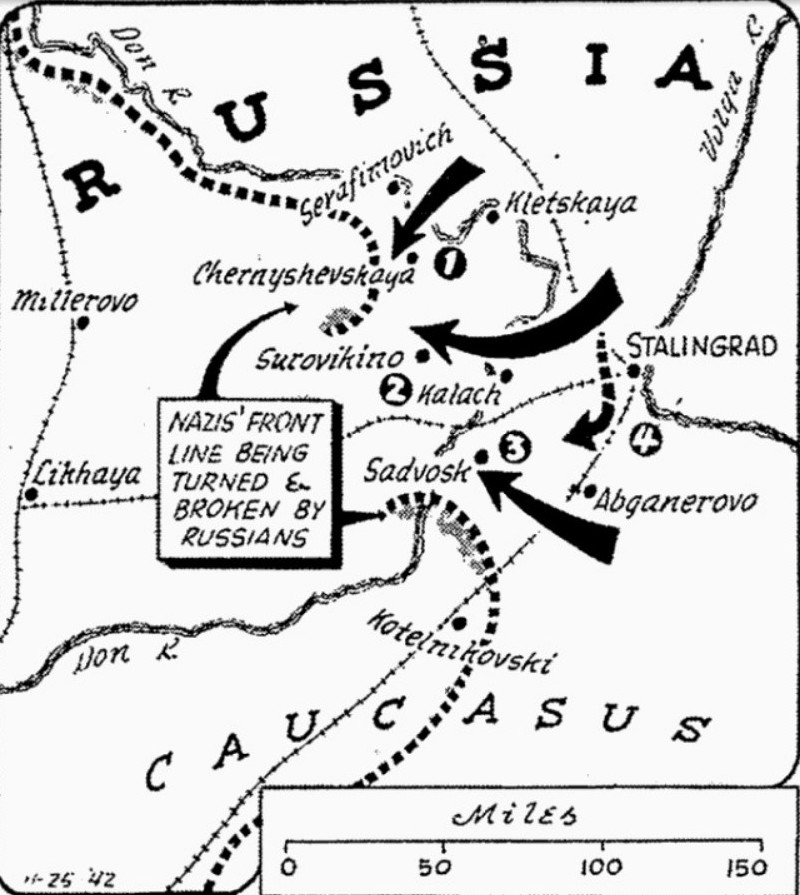The Pittsburgh Press (November 24, 1942)
Reds closing trap on Nazis
Big tank battle rages as Russians gain west of Stalingrad
By Henry Shapiro, United Press staff writer
Moscow, USSR –
A great and possible decisive tank battle raged in the area west of Stalingrad today as battered German forces, foreseeing entrapment in an iron ring forged by the Red Army, sought to rally for a counterattack.
The German High Command admitted today that the Russians penetrated defenses southwest of Stalingrad and on the Don River bend, but said Nazi countermeasures were in progress. The communiqué complained of unfavorable weather, but said “several hundred enemy tanks were destroyed.”
The Soviet offensive gained momentum. One army pushing southward reached the village of Pogodinsky, well inside the bend of the Don River, in a drive to achieve a junction with Russian forces hammering their way westward from Kalach. A third army, advancing from southern sectors, cut the railroad to Rostov and rolled on to the southeast.
The German attempt at a counterattack was having little success. One entire German division was reported exterminated in a single brief operation when it tried to cut off the Soviet wedge northwest of Stalingrad. The Russians beat off the counterassault while other forces struck the enemy flanks and encircled the division.
Another German division met a similar fate.
Col. Gen. Hermann Hoth, commander of the Germans in the Stalingrad area, hastened to develop a counteroffensive powerful enough to break the Russian drive before the big trap snapped shut and left him open to annihilation.
The inspired Russians gave him a foretaste of the peril in four days of fighting, during which 26,000 Germans were killed.
In one Stalingrad segment alone, the Russians annihilated a complete, fully-equipped infantry division of 12,000 which had arrived at the front recently. Within a few hours, the same survivors abandoned their arms and ammunition in flight.
The Russian winter was also giving the Germans a taste of disaster. The entire steppe was frozen and blanketed with snow.
The newspaper Pravda reported that the Soviet thrust south of Stalingrad across the frozen Kalmyk Steppes was developing no less successfully than the western and northwestern offensives. Large German and Romanian units, miserably clad, with blankets wrapped around their shoulders and handkerchiefs over their faces to shut out the biting wind, roamed the windswept steppes and often surrendered without a fight, the newspaper said.
Front dispatches revealed the pattern of the Soviet offensive began with diversionary attacks which deceived the enemy. The Germans threw large forces against unimportant sectors. The Russians then struck with great power in the two principal directions of their planned drive.
The army publication, Red Star, disclosed that Soviet forces were massed south of Stalingrad on the east bank of the Volga only a few days ago and hurriedly crossed the river on pontoons thrown in the freezing water.
They struck unexpectedly in the early morning with an intensive bombardment which lasted 2½ hours. Infantry then cleared the minefields for tanks which crushed one frontline and strongpoint after another. Mobile heavy and medium artillery and mine-throwers played an important role in widening the breach, crippling and panicking the Germans.
After a full day of such operations, the Soviet cavalry and motorized infantry entered the breach, fanned out and cut the railroad to Tikhoretsk, smashed numerous groups of Germans and advanced 14 miles.
From there on, there was no stopping them.
Over the Kalmyk Steppes south of Stalingrad today, the roads were clustered with overturned and burned-out enemy machines and thousands of green-uniformed corpses. Endless columns of frost-bitten prisoners streamed eastward, convoyed by Russian cavalrymen, while Soviet tanks, cavalry and motorized infantry flowed westward.
The howling west wind brought with it some German leaflets, recently printed. They demanded that the Russians surrender to the “hitherto never-defeated, invincible German Army."
The Soviet southern attack, launched originally on a 14-mile front, was bolstered considerably by occupation of Tundutovo and Aksay, roughly 40 miles apart, as Russian troops pushed out tanks and guns on each side of the assaulting force to guard against a breakthrough.
The northern attack from Serafimovich was supported from Kletskaya.
The situation had apparently become a race between Hoth’s effort to rally and counterattack and Soviet ability to reinforce its two principal assault columns and prevent a breakthrough. Hoth was tremendously handicapped by complete lack of rail communication and the fact that the Don was jammed with swirling ice floes.
The Germans appeared stunned by the swiftness of the advance, particularly around Chernyshevskaya, 110 miles west of Stalingrad, on the west side of the Don River.
Russian forces broke into one village so suddenly the Germans were unable to organize a defense. One thousand were killed, 70 trucks were smashed and 25 planes destroyed at the airdrome before they could take off.
In all these recent operations on the Stalingrad Front, the Germans lost between 50,000 and 60,000 killed and taken prisoner. Wounded undoubtedly ran their total casualties much higher.
Soviet forces that took Chernyshevskaya had presumably driven 55 miles from Serafimovich, on the south side of the Don, some 100 miles northwest of Stalingrad.
The Russians had also taken Kalach, 40 miles west of Stalingrad, on the east bank of the Don. By closing the 60-mile gap between Chernyshevskaya and Kalach, the Russians could trap more than 25 German divisions operating around Stalingrad.
There were no official indications where the Russians meant to close the pincers. The drive from the northwest might continue on southwest to Rostov-on-Don, to trap Axis forces from Stalingrad to the Caucasus Mountains in one swoop.
On the northwestern front, between Moscow and Leningrad, the Russians occupied an enemy point and killed 100 Germans. Russian forces captured fortified positions, the communiqué said, northeast of Tuapse, in the Central Caucasus, where the Germans had suffered more than 25,000 casualties in a recent Russian offensive. Soviet artillery destroyed six trucks.
Four towns fell yesterday to the Russians in addition to Chernyshevskaya – Perelazovsk and Pogodinsky, to the forces advancing from the northwest; and Tundutovo and Aksay to those driving from the south.
Eleven thousand more prisoners were captured, bringing the total to 24,000.
Booty piled up as the Nazis fled.
Booty, a communiqué said, includes 32 planes and 35 tanks in perfect working order.
Radio Berlin broadcast this strange “explanation” of Russian successes:
One of the basic points of German strategy is to open gaps from time to time so the Bolsheviks will be tempted to rush in and risk destruction. It can be assumed safely that this is what has been happening for the last week or two on the Don elbow.
It was a propaganda broadcast strictly intended for non-German consumption.
The United Press listening post in London heard Radio Berlin mention Romanian troops exhausting their ammunition, suggesting that the Germans’ supply problem had already become acute. The Germans also complained of vast numbers of Russians being thrown in against them, and of the cold, rainy and snowy weather, in which their planes could not operate effectively.

